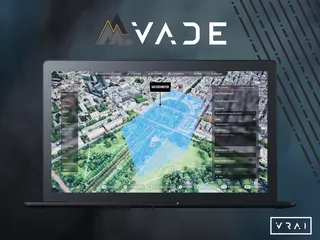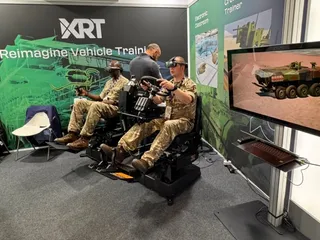Onwards and Upwards for Helicopter Training
Contact Our Team
For more information about how Halldale can add value to your marketing and promotional campaigns or to discuss event exhibitor and sponsorship opportunities, contact our team to find out more
The Americas -
holly.foster@halldale.com
Rest of World -
jeremy@halldale.com

Chuck Weirauch explores the helicopter simulation training industry and provides an update on recent progress.
With commercial helicopter sales now anticipated to increase significantly in just about every major world market, and in China at an annual double digit rate, for example, it would only follow that the number of helicopter simulator sales would increase as well. The Global Helicopter Simulators Market 2014-2018 published by Sandler Research forecasts that this market will grow at an annual rate of 2.80 percent over the period 2014-2018.
According to this report, one of the key factors contributing to this market growth is the growing demand for commercial helicopter aircraft, as well as an increasing demand for full flight simulators. But the flip side to all this good news is that, just like with the commercial fixed-wing market, there is a looming shortage of helicopter pilots. Recently Matt Zuccaro, President of the Helicopter Association International (HAI), warned there is a real chance that the industry could face a shortage of qualified pilots and mechanics in just a few years.
While helicopter training device providers are gearing up to meet the challenges of a growing market, a major goal for them is to constantly improve the replication of the flight performance of newer and increasingly capable and sophisticated helicopters equipped with the latest in avionics and instrumentation. To gain an insight into some of the latest developments, technologies and trends, CAT solicited comments from several leaders in this industry.
More Accurate Performance ReplicationFor John Frasca, president of Frasca International, a high-quality data package is essential to accurately replicate aircraft performance. OEMs often have data packages, but they can leave a lot to be desired, since sometimes they are based on pre-production aircraft and sometimes data is missing. To eliminate such discrepancies, Frasca has flight-tested a number of helicopters and collected comprehensive data packages to support up to Level D FFS’s. The next critical step is to develop the aero models, a bigger effort than the flight test, and a helicopter model and far more complex than that of a fixed-wing aircraft.
Motion cueing breaks into two areas, vibration effects and acceleration effects, Frasca explained. Vibration is improved with the incorporation of independent vibration platforms, but both are very dependent on the data package and aero models, he added.
According to Nidal Sammur, FlightSafety International's director of Engineering for Simulation, motion cueing is one of the most challenging areas of flight simulation because it is physically impossible to completely replicate this aspect of the aircraft environment. Even so, carefully crafted motion cueing can be a major contributor to creating an immersive simulation experience.
Sammur explained that FlightSafety has developed new enhanced motion cueing for fixed-wing full flight simulators and is currently deploying the technology on those new devices. The new cueing relies on objective frequency-domain testing methods to quantify system performance. According to Sammur, the enhanced motion cueing for helicopter devices will be deployed in 2014.
"Our customers will see the same or greater enhancements in performance for helicopters as we are seeing for the fixed-wing devices," he said.
According to Marc Hilaire, CAE’s VP for Technology and Innovation, the company puts an emphasis on the rotor model, validating the dynamic response of CAE’s Object-Oriented Blade Element Rotor Model flight test data in both time and frequency domains throughout the flight envelope to maximize the accuracy of aircraft handling qualities. To improve motion cueing, the newest advancements on CAE’s simulators include the use of electric vibration platforms, electric motion systems, and electric cockpit servos. These new electrical actuation systems bring the benefits of greater fidelity, higher bandwidth cues, and lower operational cost.
For the AgustaWestland team of Captain Leonardo Mecca, Head of Training, Francesco Pasqualetto, director of Training and Helicopter Support Systems, along with Regional Business manager Jon Sackett, the main current technology advantage has been the availability of good-quality commercial-off-the-shelf (COTS) products, which the company has been able to integrate successfully into its flight simulator solutions to produce high-fidelity products.
That team also reported that by combining such products with AgustaWestland's own flight test and engineering data, the company has been able to produce devices to the standards required by the civil regulatory authorities. The multinational helicopter design and manufacturing company has also found that the new generation of electrical motion systems allow for significant reductions in maintenance and facility costs, while providing comparable performance standards to the traditional hydraulic motion systems.
Better Visuals and Terrain
According to Mecca, Pasqualetto and Sackett, the use of flight simulation in helicopter flight training is becoming a must today for any part of training, even when flying VFR only. Modern visual systems are benefiting from continually improving update rates and resolution, with the ability to model more realistic scenarios and weather effects relevant to customers operations in fields such as oil and gas platforms, accident scenes and city landing platforms with associated hazards.
To provide the highest quality visuals, AgustaWestland has been taking advantages of COTS solutions for direct projection visuals that have received regulatory authority acceptance at the highest levels of certification. This means that pilots flying the company's helicopter simulators experience very realistic height perception at low levels, making the simulator much more useful for training down to ground levels for difficult tasks. These tasks include such flight elements as confined area landings and the simulation of emergencies close to the ground.
FlightSafety International's general manager of Visual Systems John Hester pointed out that increased field of view (FOV) with cross-cockpit viewing is dramatically improving the acceptance of simulator training. Helicopter cockpits generally have significantly more wind screen area than fixed wing aircraft, so greater FOV is extremely important as pilots need this extended viewing for many critical maneuvers such as hover/land. Then both the physical aspects and manufacturing resources, along with the ability to eliminate distortions as the FOV increases is paramount to creating a realistic environment, he explained. FlightSafety has accomplished both of these and more with its mirror CrewView display.
Another major factor for enhancing out-the-window views in helicopter simulators besides increasing FOVs, is the development of higher resolution and more detailed terrain databases. According to Hilaire, CAE is seeing demand for higher resolution database content simultaneously covering larger training areas. Relying solely on satellite imagery becomes cost- prohibitive under these conditions, so the company's “Motif” DB production technique has been a key factor in meeting recent program requirements, he said. Motif procedurally generates high resolution imagery suitable for both low and high level flight, with the company delivering Motif for country-sized areas.
Frasca is also now frequently delivering country-size databases with high-resolution imagery. This capability is possible with the company's Vision Global image generator, which can handle virtually unlimited database sizes. Managing the data licenses when using commercially available data is becoming a part of the effort of providing such extensive databases, Frasca pointed out.
Training TrendsAccording to Hilaire, worker transport to offshore oil and gas facilities is the helicopter world’s version of the commercial airline business. Helicopter services and support companies offer scheduled service in large- capacity helicopters and operate point to point in often difficult weather conditions. It is in this oil and gas transport domain that CAE sees the most significant and growing use of simulation training.
"There seems to be an effort towards putting training where the pilots are," Frasca said. "Training centers are being announced all over the world. Simulation is being identified by OEM’s much earlier in the aircraft development programs. And overall, the goal seems to be to have the training programs in place concurrently with aircraft deliveries," Frasca continued.
According to the AgustaWestland team, the major change from the company's perspective has been the acceptance of flight simulation by the regulators, with EASA allowing a Level D FFS to be used for the majority of a type rating, and the FAA allowing for zero-flight time conversion for such a device. Most recently, the company's customers are asking not only for instrument training, where the recognized credit towards the live helicopter from all Authorities stands as 100 percent, but also for more mission-orientated and multi-crew training to improve crew co-operation in the cockpit. Customers are also looking for courses and systems more tailored towards their operating procedures in their operating environment.
Dave Welch, director of the FlightSafety International Lafayette Learning Center in Lafayette, LA, said that more and more countries around the world are requiring pilots to attend simulation training if the simulator exists. An even larger issue is that FlightSafety's customers require their pilots to undergo simulation training as part of their qualification. They have realized the importance of simulation training in protecting their people and assets, and in controlling their costs. The customer is demanding scene models in the area where they will operate, Welch added.
In addition, Level D fidelity and scene detail is enabling more mission-oriented training tasks, such as confined area landings, realistic accident scenes, offshore platform operations, pinnacle landings, and NVG training. These more realistic training mission scenarios extrapolate to the real world, Welch noted.
More Simulation AcceptanceWhile flight schools and instructor pilots were reluctant in the past to employ helicopter FTDs and full flight simulators into their training curricula because they felt that those trainers did not replicate aircraft performance accurately enough, the consensus of the CAT sources for this article is that this trend has been largely reversed. In fact, they see even more growth in the use of simulators for flight training in the future.
"As technology advances and more high-fidelity simulators are deployed globally, we are definitely seeing both increased acceptance and adoption of simulation training," Hilaire said. "The key to continuing – and even accelerating – the growth trend on the civil side is to bring that efficiency and safety mindset to bear while leveraging technology to enhance realism and improve training experience and capability while decreasing costs by deploying training assets locally."
"Advanced cockpits are a significant force pushing the use of simulation," Frasca said. "The high cost of operating the aircraft, but perhaps more importantly the limited availability of aircraft for training, also encourages the use of simulation. Helicopters are a huge capital investment, with owners wanting them earning revenue every single day. These benefits of simulation have always existed. Obviously there is an increase in formal safety programs. Frequently these programs identify increased use of simulation as a strategy."
The AgustaWestland team feels that regulation will remain a key factor driving customers towards simulation, supported by technological advances that continue to enhance realism and drive down cost. However, the industry is already approaching the stage where concerns are being raised about ensuring that pilots have sufficient time in the aircraft, and this will limit the extent to which simulation can take over. Another aspect will be to extend training into the full-crew environment to extend the multi-crew training to further enhance performance. Here, more low-cost solutions are emerging from gaming technology that could help to drive this forward, the team predicts.
"More and more there is both the expectation and the requirement for simulation training around the globe both from regulators and customers," Welch summed up. "We are also seeing part 135 operators evaluating training programs with the goal of moving more training from the aircraft to the simulator."


